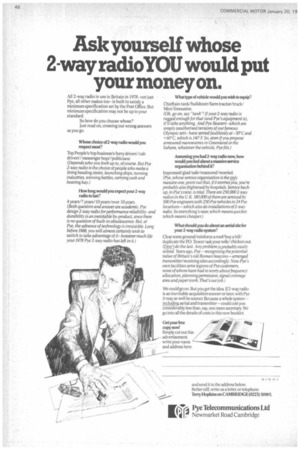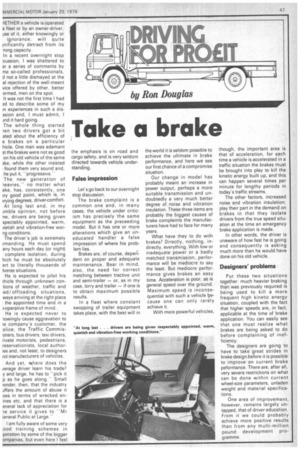Ask yourself whose 2-way radioYOU would put your money on.
Page 48

Page 49

If you've noticed an error in this article please click here to report it so we can fix it.
All 2-way radio in use in Britain in 1978 -not just Pye, all other makes too-is built to satisfy a minimum specification set by the Post Office. But minimum specification may not be up to your standard.
So how do you choose whose?
Just read on, crossing out wrong answers as you go.
Whose choice of 2-way radio would you respect most?
Top People's/top business's/lorry drivers'/cab drivers'/ messenger boys'/politicians: (Depends who you look up to, of course. But Pye 2-way radio is the choice of people who make a living heading states, launching ships, running industries, winning battles. carrying cash and heaving hay) How long would you expect your 2-way radio to last?
4 years/7 years/10 years/over 10 years. (Both question and answer are academic. Pye design 2-way radio for performance reliability-and durability is an inevitable by-product, since there is no question of built-in obsolescence. But, at Pye, the advance of technology is irresistible. Long before 1988 you will almost certainly wish to switch to take advantage of it-however much life your 1978 Pye 2-way radio has left in it.) What type of vehicle would you wish to equip?
Chieftain tank/bulldozer/farm tractor/truck/ Mini/limousine.
(Oh, go on, say "tank"! if your 2-way radio is rugged enough for that (and Pye's equipment is), it'll take anything. And Pye Beavers-which are simply weatherised versions of our famous Olympic sets-have served faultlessly at -30°C and +60°C, which is 140°F So, even if you propose armoured manoeuvres in Greenland or the Sahara, whatever the vehicle, Pye fits.) Assuming you had 2-way radio now, how would you feel about a massive service organisation behind it?
Impressed/glad/safe/reassured/worried.
(Pye, whose service organisation is the only massive one, point Out that, if it worries you, you're probably also frightened by hospitals. Service backup, in Pye's view, is vital. There are 250,0002-way radios in the U.K. 180,000 of them are serviced by 500 Pye engineers with 250 Pye vehicles in 24 Pye locations—which also do installations of 2-way radio. So everything's near, which means quicker. which means cheaper) What should you do about an aerial site for your 2-way radio system?
Clear some ground/reinforce a roof/buy a hill/ duplicate the PO. Tower/ask your wife/ chicken out. (Don't do the last. Any problem is probably easily solved. Years ago, Pye— recognisi ng the potential value of Britain's old Roman beacons—arranged transmitter/ receiving sites accordingly. Now Pye's own facilities serve legions of Pye customers, none of whom have had to worry about frequency allocation, planning permission, signal coverage area and paper work. That's our job.) We could go on. But you get the idea. If 2-way radio is an inevitable acquisition sooner or later. with Pye it may as well be sooner. Because a whole system — including aerial and transmitter—could cost you -considerably less than, say. one more secretary. We go into all the details of costs in this new booklet.
-IETHER a vehicle is operated a fleet or by an owner-driver, use of it, either knowingly or ignorance, will quite inificantly detract from its 'fling capacity.
In a recent overnight stop .cussion, I was shattered to ar a series of comments by rne so-called professionals, not a little dismayed at the al rejection of the well-meant vice offered by other, better ormed, men on the spot.
It was not the first time I had ad to describe some of my in experiences in such a disssion and, I must admit, I And it hard going.
The whole thing started 'len two drivers got a bit ated about the efficiency of e brakes on a particular hicle. One man was adamant at the brakes were not as good on his old vehicle of the same ake, while the other insisted found them very sound and, he put it, "progressive.
The new generation of leavies,no matter what ake, has, consistently, one
ry good point, which is, in Hying degrees, driver-comfort.
At long last and, in my Amble opinion, not before ne, drivers are being given spectably appointed, warm, iietish and vibration-free worn conditions.
The driver's job is extremely ?manding. He must spend any hours each day (or night) complete isolation, during hich he must be absolutely ert to literally thousands of iverse situations.
He is expected to pilot his ?hide through unknown contions of weather, traffic and lad/ offloading situations, ways arriving at the right place . the appointed time and in a )-operative frame of mind.
He is expected never to lowingly cause aggravation to ie company's customer, the ofice, the Traffic Commisoners, bus drivers, taxi drivers, rivate motorists, pedestrians, reservationists, local authores and, not least, to designers nd manufacturers of vehicles.
And yet, where does the derage driver learn his trade? y and large, he has to "pick it p as he goes along."' Small fonder, then, that the industry uffers the amount of abuse it oes in terms of wrecked enines etc, and that there is a eneral lack of appreciation for le service it gives to "Mr ieneral Public at Large.
I am fully aware of some very ood training schemes in peration by some of the bigger ompanies, but even here I feel
















































































































